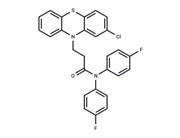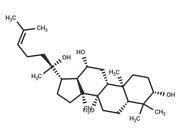| Name | (20S)-Protopanaxadiol |
| Description | (20S)-Protopanaxadiol (20-Epiprotopanaxadiol) (20-Epiprotopanaxadiol), an apoptosis inducer, is an aglycon metabolic derivative of the protopanaxadiol-type ginseng saponin. |
| Cell Research | Int-407 and Caco-2 cells are seeded at a concentration of 1×106 cells/mL in 24-well plates in separate experiments. Test ginsenosides (PPD, PPT, Rh2) are added to wells to the LC50 concentration determined previously from the MTT assays. The ginsenoside concentrations used for Int-407 cells are 23, 26, and 53 μg/mL, respectively, for PPD, PPT, and Rh2. In a similar experiment using Caco-2 cells, 24 μg/mL for both PPD and PPT and 55 μg/mL for Rh2 is used. Untreated cells represented the control. Cells are incubated at 37℃ in a 5% CO2 humidified incubator for 24, 48, and 72 h. Cell-free supernatant are obtained by centrifugation(400 g) for 10 min, and the lactate dehydrogenase (LDH) assay is conducted as previously reported.(Only for Reference) |
| In vitro | Concentrations causing growth inhibition of 50% of cells (LC50) for the compounds (20S)-Protopanaxadiol is 23 μg/ml, for Int-407 cells. The the LC50 for (20S)-Protopanaxadiol is determined to be 24 μg/ml in Caco-2 cells. In the Int-407 cell line, (20S)-Protopanaxadiol produces great percentage of sub-G1 (apoptotic) cells(The Int-407 cell line is a human embryonic nonmalignant cell line originating from fetal tissue of approximately 2 months gestation, whereas Caco-2 is a human colon adenocarcinoma cell line). This response is attributed to differences in individual ginsenoside glycosylation and, thus, the hydrophobic-hydrophilic balance [2]. Incubation with (20S)-Protopanaxadiol also significantly reduces the viability of U251-MG and U87-MG cells in a dose- and time-dependent manner. The cytotoxic effect of (20S)-Protopanaxadiol is accompanied by reduced expression of cell adhesion proteins, including N-cadherin and integrin β1, which leads to reduced phosphorylation of focal adhesion kinase. Furthermore, incubation with (20S)-Protopanaxadiol reduces the expression of cyclin D1 and subsequently induces cell-cycle arrest at the G1 phase[3]. |
| In vivo | Treatment with (20S)-Protopanaxadiol and PPT prior to immobilization stress increase the time spent in open arms and open arm entries in the elevated plus-maze (EPM) test. Treatment with (20S)-Protopanaxadiol potently suppresses immobilization stress-induced serum levels of corticosterone and interleukin (IL)-6 by the enzyme-linked immunosorbent assay. (20S)-Protopanaxadiol and PPT may exhibit the anxiolytic effect via γ-aminobutyrateA (GABAA) receptor(s) and serotonergic receptor(s), respectively, and (20S)-Protopanaxadiol may have an anti-inflammatory effect that is more potent than that of PPT[1]. |
| Storage | Powder: -20°C for 3 years | In solvent: -80°C for 1 year | Shipping with blue ice. |
| Solubility Information | Ethanol : 31 mg/mL (67.3 mM)
DMSO : 85 mg/mL (184.6 mM)
H2O : < 1 mg/mL (insoluble or slightly soluble)
|
| Keywords | ginseng | Cluster of differentiation 243 | (20S)Protopanaxadiol | 20APPD | P-glycoprotein | Apoptosis | ABCB1 | CD243 | (20S) Protopanaxadiol | Pgp | (20S)-Protopanaxadiol | MDR1 | various tumor cells | Reactive Oxygen Species | Protopanaxadiol | Multidrug resistance protein 1 | inhibit | Inhibitor | P-gp | saponins | Akt activity |
| Inhibitors Related | Stavudine | 5-Fluorouracil | Imeglimin hydrochloride | Myricetin | Dextran sulfate sodium salt (MW 4500-5500) | Sodium 4-phenylbutyrate | L-Ascorbic acid | Metronidazole | Sorafenib | Tributyrin | Salicylic acid | Oleic acid |
| Related Compound Libraries | Anti-Tumor Natural Product Library | Bioactive Compound Library | Membrane Protein-targeted Compound Library | Selected Plant-Sourced Compound Library | Anti-Inflammatory Traditional Chinese Medicine Compound Library | Tobacco Monomer Library | Anti-Aging Compound Library | Bioactive Compounds Library Max | Ancient Chinese Classical Formulas Compound Library |

 United States
United States



